 20. Ferrari 312T2
20. Ferrari 312T2
(1976 to 1978)
Victories: 9
Honours: Drivers' Championship 1977, Constructors' Championship 1977
Success rate: 28.1%
Principal designer: Mauro Forghieri
Winning drivers: Niki Lauda, Carlos Reutemann
Engine: Ferrari 3.0 F12
The successor to the successful 312T, the 312T2 was even more competitive and if not for Niki Lauda's fiery accident at the Nürburgring in 1976 it would have won much more. As it was, it delivered both titles in 1977 and improved on the concepts realised in its predecessors. One major development was its incorporation of air ducts on the sides of the cockpit.
 19. Williams FW11
19. Williams FW11
(1986)
Victories: 9
Honours: Constructors' Championship 1986
Success rate: 56.25%
Principal designers: Patrick Head and Frank Dernie
Winning drivers: Nigel Mansell, Nelson Piquet
Engine: Honda 1.5 V6T
Williams should have taken the drivers' title alongside its constructors' crown in 1986, but fate conspired against it and Nigel Mansell was eliminated from the last race showdown in Adelaide with a blown tyre forcing team-mate Nelson Piquet to take a pitstop in case the same thing happened to him. With Frank Williams out of action for the season following the road accident that paralysed him, Patrick Head was in charge of the team and did himself proud. The powerful Honda unit was the envy of the field.
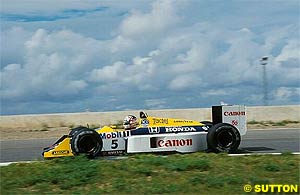 =. Williams FW11B
=. Williams FW11B
(1987)
Victories: 9
Honours: Drivers' Championship 1987, Constructors' Championship 1987
Success rate: 56.25%
Principal designers: Patrick Head and Frank Dernie
Winning drivers: Nelson Piquet, Nigel Mansell
Engine: Honda 1.5 V6T
The 1987 season was 1986 replayed for Williams, although on this occasion Nelson Piquet secured the drivers' title. The FW11B was an updated version of the previous year's car, with the few gremlins it had ironed out. The Honda engine was as powerful as ever, but was consequently poached by McLaren for 1988, leaving Williams in a fix for 1988.
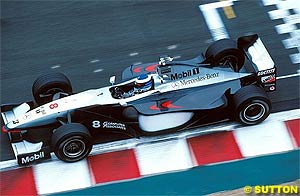 =. McLaren MP4-13
=. McLaren MP4-13
(1998)
Victories: 9
Honours: Drivers' Championship 1998, Constructors' Championship 1998
Success rate: 56.25%
Designers: Adrian Newey
Winning drivers: Mika Hakkinen, David Coulthard
Engine: Mercedes 3.0 V10
McLaren's return to form was a beautiful beast from the pen of Adrian Newey, who McLaren had poached from Williams in order to reverse the team's flagging fortunes. It hadn't won the championship since 1991, but in 1998 produced an elegant performance to take both crowns. The only fly in the ointment was the Mercedes engine, which although powerful was unreliable, but in the end Mika Häkkinen held Michael Schumacher's Ferrari at bay to take the title.
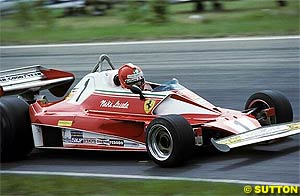 16. Ferrari 312T
16. Ferrari 312T
(1975 to 1976)
Victories: 9
Honours: Drivers' Championship 1975 Constructors' Championship 1975 and 1976
Success rate: 60%
Principal designer: Mauro Forghieri
Winning drivers: Niki Lauda, Clay Regazzoni
Engine: Ferrari 3.0 F12
Based on the revolutionary but ugly 312B3, Ferrari's 312T introduced a transverse gearbox to the race-winning package on the way to Niki Lauda's first title. The 'shovel-nosed' 312B3 had introduced side-mounted radiators and a central fuel cell, but it was the 312T that refined the package and introduced the greater reliability needed to mount a championship challenge. The car brought Ferrari its first titles for 11 years.
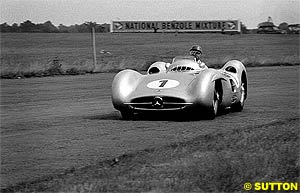 15. Mercedes W196
15. Mercedes W196
(1954 to 1955)
Victories: 9
Honours: Drivers' Championship 1954 and 1955
Success rate: 75%
Principal designer: Rudolf Uhlenhaut
Winning drivers: Juan Manuel Fangio, Stirling Moss
Engine: Mercedes-Benz 2.5 L8
In motorsport folklore, Mercedes' W196 was unbeatable. In reality it 'only' won 75% of the races it entered but was still one of the greatest cars of all time. In appearance the streamlined racer more resembled a sportscar than a grand prix car, and earlier on ran a closed-wheel version which exploited a loophole in the regulations. Its five-speed gearbox also provided a significant advantage over its four-speed rivals. Its short but glorious career was a feat of German engineering.
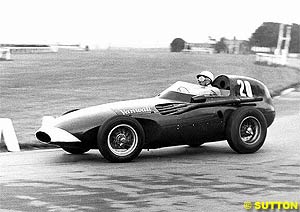 =. Vanwall VW (57)
=. Vanwall VW (57)
(1957 to 1958)
Victories: 9
Honours: Constructors' Championship 1958
Success rate: 75%
Principal designer: Frank Costin
Winning drivers: Stirling Moss, Tony Brooks
Engine: Vanwall 2.5 L4
Vanwall's victory at the 1957 British Grand Prix was a significant moment in motorsport as it provided the first win for a British car in the Formula One world championship. The VW (57) was designed by Frank Costin, but Colin Chapman had worked as a consultant on it. The VW (57) parted with tradition by using the best parts available to Vanwall, regardless of whether or not they were made in Britain.
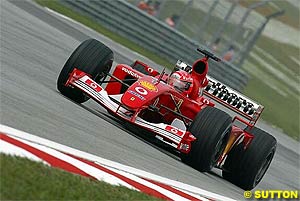 13. Ferrari F2001
13. Ferrari F2001
(2001 and 2002)
Victories: 10
Honours: Drivers' Championship 2001 and 2002, Constructors' Championship 2001 and 2002
Success rate: 50%
Principal designer: Rory Byrne
Winning drivers: Michael Schumacher
Engine: Ferrari 3.0 V10
Such a display of dominance by one team hadn't been seen since Williams in 1996. The best efforts of Williams and McLaren looked weak by comparison to Byrne's dream machine and its astounding aerodynamic efficiency. It had an amazing reliability record, facilitated by Ferrari's decision to deploy two test teams to its rivals' one. Both championships were wrapped up by the Hungarian Grand Prix in mid August. The car was wheeled out for the beginning of the 2002 season and was still good enough to dominate the field.
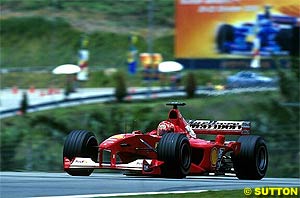 12. Ferrari F1-2000
12. Ferrari F1-2000
(2000)
Victories: 10
Honours: Drivers' Championship 2000, Constructors' Championship 2000
Success rate: 58.8%
Principal designer: Rory Byrne
Winning drivers: Michael Schumacher, Rubens Barrichello
Engine: Ferrari 3.0 V10
Ferrari hadn't won a drivers' championship for 21 years when the F1-2000 came along, despite coming very close for the past three seasons. The new car succeeded where its ancestors had failed, combining speed with bullet proof reliability in a triumph for the team's engineering staff. Only McLaren's MP4-15 succeeded in providing it with a challenge and no other team won a race that season.
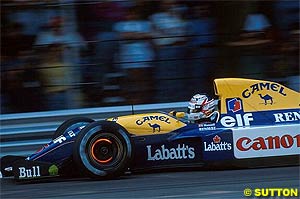 11. Williams FW14B
11. Williams FW14B
(1992)
Victories: 10
Honours: Drivers' Championship 1992, Constructors' Championship 1992
Success rate: 62.5%
Principal designer: Adrian Newey
Winning drivers: Nigel Mansell, Riccardo Patrese
Engine: Renault 3.5 V10
The FW14B has been voted the greatest Formula One car ever on numerous occasions and is undoubtedly Adrian Newey's finest work. The chassis was perfect, the engine powerful and reliable and the driver aids and active suspension second to none. It is often said that with another top calibre driver partnering Nigel Mansell it might have won every race that year. As it was, only valiant efforts from Ayrton Senna and Michael Schumacher in much weaker McLarens and Benettons succeeded in taking wins away from it.
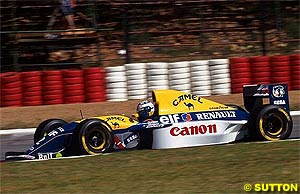 =. Williams FW15C
=. Williams FW15C
(1993)
Victories: 10
Honours: Drivers' Championship 1993, Constructors' Championship 1993
Success rate: 62.5%
Principal designer: Adrian Newey
Winning drivers: Alain Prost, Damon Hill
Engine: Renault 3.5 V10
Stability in the regulations and the problems of its rivals gave Williams the best possible opportunity to follow up its FW14B with another dominant vehicle. Despite a completely new driver line up, Newey's FW15C delivered the goods yet again and the car's driver aids package was on a different level to its rivals.
 9. McLaren MP4-5
9. McLaren MP4-5
(1989)
Victories: 10
Honours: Drivers' Championship 1989, Constructors' Championship 1989
Success rate: 62.5%
Principal designer: Gordon Murray
Winning drivers: Alain Prost, Ayrton Senna
Engine: Honda 3.5 V10
The other teams were spurred on by McLaren's dominance in 1988 and thus gave the team a tougher time in 1989, when McLaren was forced to swap its turbo for a normally-aspirated engine. All the same, McLaren took 10 victories and both championships. The car's technical excellence was somewhat overshadowed when the rivalry between Prost and Senna turned nasty, with both MP4/5s ending up in the escape road at Suzuka, but it was a worthy successor to the MP4/4. The car provided the basis for the following year's winning car, the MP4/5B, which won six races itself.
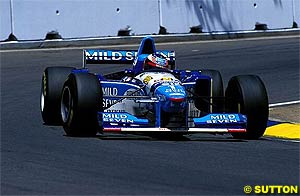 8. Benetton 195
8. Benetton 195
(1995)
Victories: 11
Honours: Drivers' Championship 1995, Constructors' Championship 1995
Success rate: 64.7%
Principal designer: Rory Byrne
Winning drivers: Michael Schumacher, Johnny Herbert
Engine: Renault 3.0 V10
Most observers consider Adrian Newey's Williams FW17 to be the best car of 1995, but it was the Benetton 195 that clocked up the most victories, largely due to Michael Schumacher's superiority over the Williams duo of Damon Hill and David Coulthard. The Brawn and Byrne technical team that has since propelled Ferrari to its great recent successes created a trustworthy and reliable car, perfectly suited to Michael Schumacher's demands. With the unbeatable Renault engine in the back, Byrne and co had maximised the potential of their package.
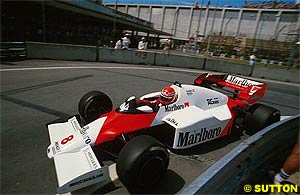 7. McLaren MP4-2
7. McLaren MP4-2
(1984)
Victories: 12
Honours: Drivers' Championship 1984, Constructors' Championship 1984
Success rate: 75%
Principal designer: John Barnard
Winning drivers: Niki Lauda, Alain Prost
Engine: TAG Porsche 1.5 V6T
The MP4/1 had introduced the carbon fibre chassis to the sport in 1981, but it was the MP4/2 that utilised that technology to bring first titles for John Barnard and Ron Dennis. As has often happened in Formula One history, McLaren lined up a fantasy team of two eventual multiple world champions, Niki Lauda in the twilight of his career and Alain Prost looking to take his first crown. They helped the team put on the most dominant show by a team in the sport for two decades. The challenge was thrilling, with Lauda taking the title by half a point at the final race.
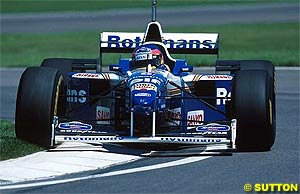 =. Williams FW18
=. Williams FW18
(1996)
Victories: 12
Honours: Drivers' Championship 1996, Constructors' Championship 1996
Success rate: 75%
Principal designer: Adrian Newey
Winning drivers: Damon Hill, Jacques Villeneuve
Engine: Renault 3.0 V10
It might not be most people's choice of the best car from Williams or Adrian Newey, but in a season when the opposition was in disarray it became the most successful. With Benetton struggling after the defection of Michael Schumacher to Ferrari, and Ferrari going through a period of atrocious reliability and inconsistency, the smooth and tidy FW18 had it all its own way.
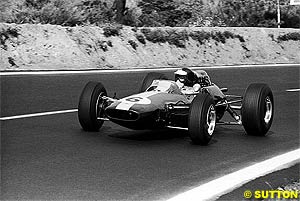 5. Lotus 25
5. Lotus 25
(1962 to 1965)
Victories: 14
Honours: Drivers' Championship 1963 and 1965, Constructors' Championship 1963 and 1965
Success rate: 46.7% (excluding private entries)
Principal designer: Colin Chapman
Winning drivers: Jim Clark
Engine: Climax 1.5 V8
The Lotus 25 was the car that produced the first jewels of Colin Chapman's assault on Formula One. Inextricably linked with Jim Clark, it brought the quiet Scotsman both his world championships and he was at the wheel for all the car's 14 wins. Chapman paved the way for the future with Formula One's first full monocoque chassis, making the Lotus 25 smaller, lighter and more rigid than its rivals. Its supple suspension was widely admired.
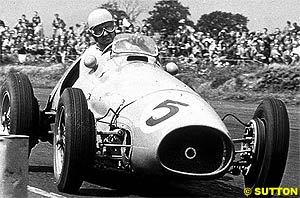 4. Ferrari 500
4. Ferrari 500
(1952 to 1953)
Victories: 14
Honours: Drivers' Championship 1952 and 1953
Success rate: 93.3% (excluding private entries)
Principal designer: Aurelio Lampredi
Winning drivers: Alberto Ascari, Piero Taruffi
Engine: Ferrari 2.0 L4
Technically the Ferrari 500 wasn't even a Formula One car, but made its debut in 1952 when the world championship was opened up to Formula Two cars owing to a shortage of entrants. Designer Aurelio Lampredi had already produced a very competitive F2 car and adapted it expertly for Formula One. The 500 has the best success rate of any Ferrari, winning every race it entered but one in the 1952 and 1953 seasons. The simple but effective car brought the Scuderia its first championship and made a legend of star driver Alberto Ascari, before the introduction of the 2.5 litre formula in 1954 brought its illustrious career to an end.
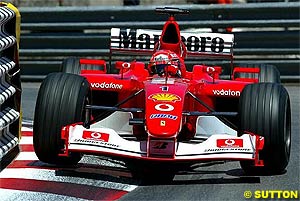 3. Ferrari F2002
3. Ferrari F2002
(2002 to 2003)
Victories: 15
Honours: Drivers' Championship 2002 and 2003, Constructors' Championship 2002 and 2003
Success rate: 78.9%
Principal designer: Rory Byrne
Winning drivers: Michael Schumacher, Rubens Barrichello
Engine: Ferrari 3.0 V10
Ferrari's 2001 chassis, the F2001, was so good that no one expected that it could be bettered by so much. But the F2002 made the F2001 look merely reasonable. Introduced at the third race of the 2002 season because of 'reliability fears', it blew the opposition away immediately and delivered Michael Schumacher the drivers' championship by July and Ferrari the constructors' title a month later. Its low compact rear end has quickly been copied by rivals. For the rest of the season it was defeated only once, by David Coulthard's McLaren MP4-17 at Monaco, and set previously unheard of reliability standards. Its reputation was tarnished a little when Ferrari decided to run it in the first four races of 2003 and it was defeated three times. When Rory Byrne promised it was the best Ferrari ever at its launch, it was no exaggeration.
 2. McLaren MP4-4
2. McLaren MP4-4
(1988)
Victories: 15
Honours: Drivers' Championship 1988, Constructors' Championship 1988
Success rate: 93.75%
Principal designer: Gordon Murray
Winning drivers: Ayrton Senna, Alain Prost
Engine: Honda 1.5 V6T
The McLaren MP4/4 was so good that when Alain Prost first drove it he said he was 'embarrassed'. In terms of wins to starts, it is the greatest ever Formula One car. In the 16 races that made up the 1988 season it failed to collect the winner's trophy just once, a costly Senna slip-up paving the way for an emotional Ferrari victory at Monza in the wake of the death of Enzo Ferrari. With such dominance the season might easily have been boring but the battle between bitter rivals Prost and Senna was enthralling, with the younger Brazilian eventually taking the crown. Ron Dennis's line up read like a dream team: the two best drivers, ace designer Gordon Murray's best ever chassis and a powerful Honda engine. Even had several of its rivals not wrong-footed and decided to go for normally-aspirated engines a year earlier than was necessary, it would still have stolen the show.
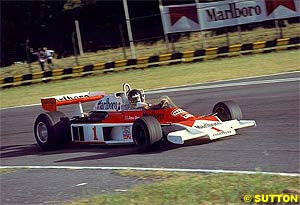 1. McLaren M23
1. McLaren M23
(1973 to 1976)
Victories: 16
Honours: Drivers' Championship 1974 and 1976, Constructors' Championship 1974
Success rate: 26.7% (excluding private entries)
Principal designer: Gordon Coppuck
Winning drivers: Denny Hulme, Peter Revson, Emerson Fittipaldi, Jochen Mass, James Hunt
Engine: Ford Cosworth DFV 3.0 V8
With Ferrari the only team of any note running without a Ford Cosworth DFV engine and a host of top-line drivers, it shouldn't have been possible for any team to produce such consistently strong results in the mid 1970s. But McLaren's M23 was a flawless chassis that took on the Ferraris and Lotuses with panache even at the end of its four year career. Former Indy Car designer Gordon Coppuck had never designed a Formula One car before, but based his model on Colin Chapman's revolutionary Lotus 72 - and produced an imitation even better than the original. The chassis utilised the McLaren M19's revolutionary rising suspension and was the first F1 car to need a detachable steering wheel to allow the driver to climb from the cramped cockpit. Drivers praised the ease of it handling. Although most famous for James Hunt's thrilling championship victory in 1976, this was the car that brought McLaren its first championship and gave Jody Scheckter and Gilles Villeneuve their Grand Prix debuts.
Notes:
1. Cars are listed in order of most victories. Where cars tie on number of wins, the ratio of wins to starts is used to separate them.
2. Modern day 'B' versions are not listed as separate chassis as usually only comparatively minor modifications have been made. Further back in time B versions are listed separately wherever relevant as they were often more different from each other as successive years' chassis in the modern era. If the different versions of these chassis are listed as one, the top ten would read 1: McLaren MP4/2, MP4/2B, MP4/2C, 2 wins; 2: Lotus 72C, 72D, 72E, 20 wins; 3: Williams FW11, FW11B, 18 wins; 4: Williams FW14, FW14B 17 wins; 5: McLaren MP4/5, MP4/5B 16 wins; 6: McLaren M23, 16 wins; 7: McLaren MP4/4, 15 wins; 8: Ferrari F2002, 15 wins; 9: Ferrari 500: 14 wins; 10: Lotus 25, 14 wins.
3. Assessments of drivers by numbers of victories are often distorted as in the 1950s seasons often consisted of six races in comparison to 16 or 17 races today. In this list this is partly balanced out as cars in the 1950s would often compete for around three seasons as the pace and budget for development was slower. However, in the early to mid 1970s cars would often run for two or three seasons of 12 to 17 races each.
About the author:
Formula One journalist Caroline Reid has written for publications such as F1 Magazine, EuroBusiness and BusinessF1. She is now a freelance journalist, working in London.
© 2007 autosport.com
. This service is provided under the Atlas F1 terms and conditions.
Please Contact Us for permission to republish this or any other material from Atlas F1.

 20. Ferrari 312T2
20. Ferrari 312T2 19. Williams FW11
19. Williams FW11 =. Williams FW11B
=. Williams FW11B =. McLaren MP4-13
=. McLaren MP4-13 16. Ferrari 312T
16. Ferrari 312T 15. Mercedes W196
15. Mercedes W196 =. Vanwall VW (57)
=. Vanwall VW (57) 13. Ferrari F2001
13. Ferrari F2001 12. Ferrari F1-2000
12. Ferrari F1-2000 11. Williams FW14B
11. Williams FW14B =. Williams FW15C
=. Williams FW15C 9. McLaren MP4-5
9. McLaren MP4-5 8. Benetton 195
8. Benetton 195 7. McLaren MP4-2
7. McLaren MP4-2 =. Williams FW18
=. Williams FW18 5. Lotus 25
5. Lotus 25 4. Ferrari 500
4. Ferrari 500 3. Ferrari F2002
3. Ferrari F2002 2. McLaren MP4-4
2. McLaren MP4-4 1. McLaren M23
1. McLaren M23